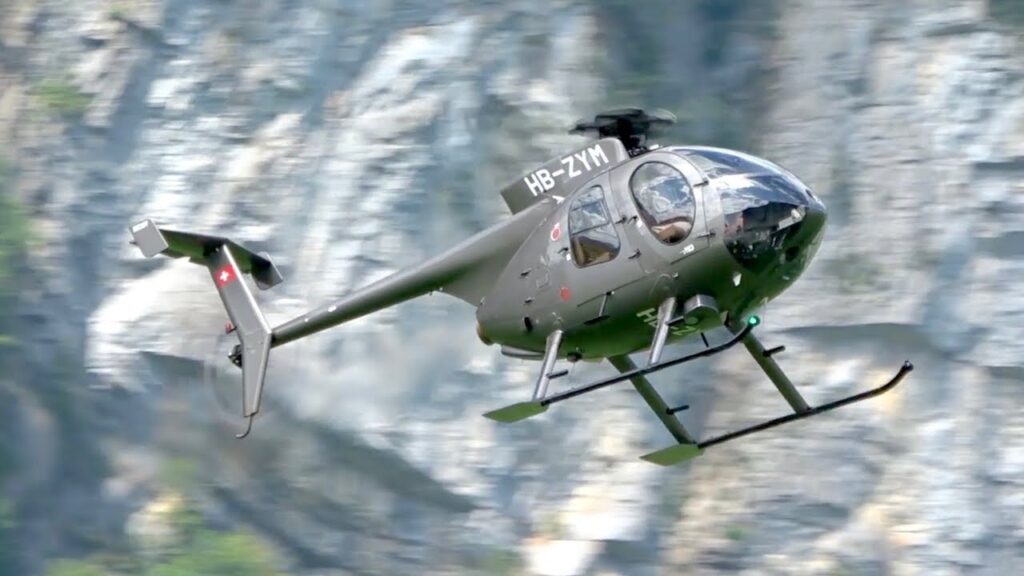A Comprehensive Review of the Hughes 530 Helicopter
The Hughes 530 Helicopter, often referred to as the Hughes 500, is a lightweight, multi-purpose helicopter renowned for its versatility and performance. Originally manufactured by Hughes Helicopters, it has since become a product of MD Helicopters.
Design and Performance
The design of the Hughes 530 is highly compact and streamlined, allowing for excellent maneuverability. It is powered by a Rolls-Royce 250-C30 turboshaft engine, which provides it with impressive speed and power. The helicopter has a maximum speed of 152 knots and a range of 375 nautical miles. Its five-bladed rotor system, coupled with the powerful engine, ensures a smooth and stable flight, even in challenging weather conditions.
Utility and Applications
The Hughes 530 is incredibly versatile, making it suitable for a variety of roles and applications. It has been extensively used in both military and civilian contexts. In the military, it is used for tasks such as reconnaissance, troop transport, and light attack missions. For civilian purposes, it serves in law enforcement, air ambulance, aerial survey, and VIP transport roles. The spacious cabin can accommodate up to five passengers, offering a comfortable and efficient travel solution.
Safety and Innovation
The Hughes 530 boasts a range of safety features, including energy-absorbing landing gear and a crash-resistant fuel system. It also incorporates several innovative technologies, such as an advanced avionics suite and a fully articulated rotor system. These features, combined with its reliability and ease of maintenance, make the Hughes 530 a standout choice in its class.
Understanding the Technology Behind the Hughes 530
The Hughes 530 is a remarkable piece of technology, a helicopter that was engineered with exceptional precision and attention to detail. This lightweight, single-engine helicopter was developed by Hughes Helicopters, a company that has a long history of pioneering advancements in the field of aviation technology.
Design and Performance
The Hughes 530 stands out for its advanced design and impressive performance. It features a five-blade main rotor and a two-blade tail rotor, an innovative configuration that provides superior stability and control. The main rotor is fully articulated, which allows for remarkable maneuverability. This helicopter is powered by a Rolls-Royce 250-C20B turboshaft engine, which delivers a maximum speed of 152 mph and a range of 375 miles. The engines power and reliability, combined with the helicopters lightweight design, make the Hughes 530 a highly efficient and versatile machine.
Advanced Avionics
Another key aspect of the Hughes 530 technology is its advanced avionics. The helicopter is equipped with state-of-the-art navigation and communication systems, including GPS, VHF radio, and a transponder. These systems enable the pilot to navigate with precision and communicate effectively, even in challenging conditions. Additionally, the cockpit is designed for optimal visibility and ease of operation, with all controls and instruments within easy reach of the pilot.
The Hughes 530s combination of innovative design, powerful performance, and advanced avionics make it a leading choice in the field of aviation. This technology, honed over years of research and development, has cemented Hughes Helicopters reputation as a pioneer in the industry.
Exploring the Historical Significance of the Hughes 530
The Hughes 530, an American light helicopter developed by Hughes Helicopters, is an embodiment of technological advancements and a significant milestone in the history of aviation. First flown in 1960, this helicopter served as a cornerstone in the development of lightweight, multi-purpose aircraft.
Hughes 530 in Military Service
The Hughes 530s Impact on Military Operations
The Hughes 530 made a lasting impact on military operations worldwide. Initially designed for utility and emergency rescue missions, the helicopter was quickly recognized for its potential in combat situations. The Hughes 530s lightweight design and superior maneuverability made it an ideal candidate for observation, direct fire support, and personnel transport during the Vietnam War. The aircrafts adaptability and versatility significantly altered the way military operations were conducted, marking a pivotal point in military aviation history.
Technological Innovations of the Hughes 530
Advanced Design and Performance
The Hughes 530 is renowned for its advanced design and high performance. The helicopter introduced a range of technological innovations that were groundbreaking at the time. These included a “no tail rotor” (NOTAR) design for improved safety and noise reduction, and a highly efficient five-bladed main rotor. The Hughes 530 also boasted an exceptional power-to-weight ratio, making it one of the fastest light helicopters of its time. The technological advancements of the Hughes 530 not only marked a significant leap in aviation technology but also set new standards for helicopter design.
Hughes 530 in Civilian Use
Commercial and Emergency Services
Beyond its military applications, the Hughes 530 played a significant role in civilian sectors. The helicopters exceptional speed, range, and payload capabilities made it a popular choice for commercial operators. The Hughes 530 was also extensively used in emergency services, such as search and rescue operations and medical evacuations, due to its versatility and reliability. The helicopters contributions to civilian aviation further underline its historical significance.
How the Hughes 530 Revolutionized the Aviation Industry
The Hughes 530, a five-seat, single-engine, light utility helicopter, has indeed played a significant role in revolutionizing the aviation industry. First introduced in the 1970s by Hughes Helicopters, it quickly became renowned for its impressive performance and versatility, altering the way helicopters were perceived and used in various sectors.
One of the significant innovations that the Hughes 530 brought to the table was its improved maneuverability. This was largely due to its unique tail rotor design, also known as the “NOTAR” system. The NOTAR (No Tail Rotor) system provided unprecedented control, safety, and quiet operation, significantly reducing the risk of accidents. This was a major breakthrough, as traditional tail rotors were often the cause of numerous helicopter accidents.
Impacts on Commercial and Military Aviation
The Hughes 530 also played a transformative role in both commercial and military aviation. Its lightweight design and superior performance made it a preferred choice for various applications, including news gathering, law enforcement, and emergency medical services. In the military domain, it was used extensively for reconnaissance, troop transport, and light attack missions, demonstrating its adaptability and resilience in challenging environments.
Moreover, the Hughes 530 was among the first helicopters to incorporate turbine engines, offering greater power, reliability, and fuel efficiency compared to the piston engines used in previous models. This advancement greatly enhanced the helicopters range and operational capabilities, further solidifying its place as a game-changer in the aviation industry.
Comparing the Hughes 530 with Other Helicopters in its Class
When it comes to comparing the Hughes 530 with other helicopters in its class, several factors come into play. Some of these include speed, maneuverability, payload capacity, and operational range. The Hughes 530, also known as the MD 500, is a light utility helicopter known for its exceptional performance and agility.
One of the main competitors of the Hughes 530 is the Bell 206. The Bell 206 is renowned for its reliability and low operating costs. However, the Hughes 530 outperforms the Bell 206 in terms of speed, boasting a maximum speed of 152 knots compared to the Bells 120 knots. Furthermore, the Hughes 530 also offers superior maneuverability, making it an excellent choice for operations in challenging environments.
Payload Capacity and Operational Range
In terms of payload capacity and operational range, the Hughes 530 also stands out. It can carry a maximum payload of around 1,500 pounds, which is more than what the Bell 206 can handle. Its operational range is approximately 375 miles, making it a versatile option for a variety of missions. Comparatively, the Robinson R44, another helicopter in the same class, falls short with a range of 350 miles and a lower payload capacity.
When you compare the Hughes 530 with other helicopters in its class, such as the Bell 206 and the Robinson R44, it is clear that the Hughes 530 offers a blend of speed, maneuverability, and operational range that is hard to match. This makes it a popular choice for both civilian and military applications.



